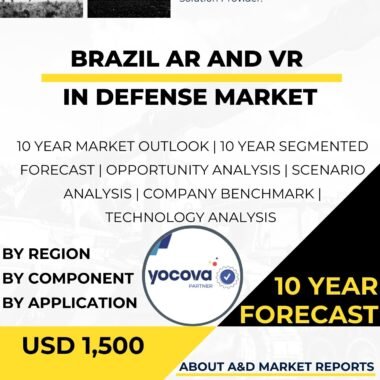Description
Canada AR & VR in Defense Market
Canada AR & VR in Defense Market technologies in defense applications has significantly transformed the country’s military capabilities and training methods. AR & VR in Defense are immersive technologies that enable users to experience virtual environments and interact with digital content, enhancing situational awareness, training effectiveness, and decision-making processes.
In the defense sector, AR and VR technologies are utilized for a wide range of applications, including training, simulation, maintenance, mission planning, and situational awareness.
AR and VR training programs have revolutionized the way Canadian Armed Forces personnel are trained. These technologies provide realistic and immersive training scenarios, allowing troops to practice in simulated environments that replicate real-world situations.
For instance, infantry soldiers can engage in virtual combat exercises that simulate urban warfare, while pilots can practice flight maneuvers and emergency procedures in virtual cockpits.
This type of training allows personnel to gain valuable experience and hone their skills in a safe and controlled environment, reducing the risk of injury and equipment damage during live exercises.
AR and VR technologies also play a significant role in enhancing mission planning and coordination. Military commanders can use AR and VR tools to visualize and analyze complex battlefields, integrating information from multiple sources to make informed decisions.
Virtual mission rehearsals allow commanders to test different strategies and tactics before executing them in the field, improving mission success rates and minimizing potential risks.
Furthermore, AR and VR technologies are used for maintenance and repair tasks. Maintenance crews can use AR headsets to access digital repair manuals and overlays that guide them through complex maintenance procedures.
This capability streamlines maintenance processes, reduces downtime, and ensures that equipment is kept in optimal condition, enhancing the readiness and operational effectiveness of the Canadian Armed Forces.
AR and VR technologies are also valuable for situational awareness. Military personnel can use AR systems to overlay digital information onto their physical surroundings, providing real-time data on terrain, enemy positions, and friendly forces.
This augmented information enhances situational awareness and facilitates better decision-making on the battlefield.
Moreover, AR and VR technologies enable collaborative training and planning across different military units and locations. Virtual training exercises can be conducted remotely, allowing personnel from various bases to participate in joint training sessions and simulations.
This capability fosters cooperation and coordination among different units, enhancing interoperability and overall military effectiveness.
The Canadian defense industry has played a crucial role in the development and integration of AR and VR technologies in defense applications. Defense companies and research institutions in Canada have invested in cutting-edge research and development to create advanced AR and VR solutions tailored to the specific needs of the Canadian Armed Forces.
The government’s support for defense innovation and technology development has encouraged the growth of a thriving AR and VR industry in Canada.
Additionally, Canada’s participation in multinational defense initiatives and alliances has facilitated knowledge exchange and collaboration in the field of AR and VR technologies.
As the field of AR and VR continues to evolve, Canada’s defense industry remains at the forefront of innovation, exploring new possibilities for these technologies in defense applications.
In conclusion, Canada’s adoption of AR and VR technologies in defense has revolutionized the way the Canadian Armed Forces train, plan missions, conduct maintenance, and enhance situational awareness.
AR and VR training programs provide realistic and immersive experiences that prepare troops for real-world scenarios, while virtual mission rehearsals improve mission planning and coordination.
Maintenance tasks are streamlined through AR overlays, reducing downtime and enhancing equipment readiness.
AR and VR technologies also offer enhanced situational awareness on the battlefield, enabling better decision-making and coordination among military units.
Canada’s commitment to defense innovation and collaboration with the defense industry and international partners has positioned the country as a leader in the application of AR and VR technologies in defense.
As technology continues to advance, Canada’s defense industry will undoubtedly explore new possibilities for AR and VR technologies, ensuring that the Canadian Armed Forces remain at the forefront of military capabilities and readiness.




